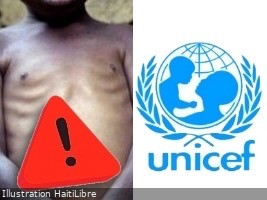![]()
Haiti – FLASH: ‘Nutrition crisis could cost the lives of countless children’, UNICEF says
2024/03/31 09:30:23
 |
Recent results from an analysis conducted by the Integrated Food Security Classification Framework (IPC) show that the number of children suffering from severe acute malnutrition (SAM) in Haiti has increased by an alarming 19% this year. Furthermore, her latest IPC analysis shows that 1.64 million people face significant levels of acute food insecurity (IPC Phase 4), putting children at particular risk of wasting and malnutrition in eight regions of the country. It’s increasing.
Armed violence in the departments of Artibonite and Ouest, which includes Port-au-Prince, has disrupted the delivery of aid, overwhelmed an already fragile health system and left more than 125,000 children at risk of severe acute malnutrition. It poses a serious threat to life. and related illnesses.
“Violence and instability in Haiti have implications far beyond the risks associated with the violence itself. This situation is creating a health and nutrition crisis that could cost the lives of countless children.“Thousands of children are on the brink, and essential supplies are being made available once the violence stops and roads and hospitals reopen,” said UNICEF Executive Director Catherine Russell. “This nutritional crisis is completely man-made. There is an urgent need to improve the basic security situation.” They are necessary for the Haitian people, for the critical services they depend on to function, and for humanitarian workers to reach children and families who desperately need them.
Since January, the deteriorating security situation in Haiti has continued to exacerbate the humanitarian crisis, severely impacting UNICEF’s ability to store, deliver and resupply much-needed aid to the population.
Earlier this month, one in 17 UNICEF containers was looted from the Caribbean Ports Authority in Port-au-Prince. Recent results from an analysis conducted by the Integrated Food Security Classification Framework (IPC) show that the number of children suffering from severe acute malnutrition (SAM) in Haiti has increased by an alarming 19% this year. Furthermore, her latest IPC analysis shows that 1.64 million people face significant levels of acute food insecurity (IPC Phase 4), putting children at particular risk of wasting and malnutrition in eight regions of the country. It’s increasing.
Armed violence in the departments of Artibonite and Ouest, which includes Port-au-Prince, has disrupted the delivery of aid, overwhelmed an already fragile health system and left more than 125,000 children at risk of severe acute malnutrition. It poses a serious threat to life. and related illnesses.
“Violence and instability in Haiti have implications far beyond the risks associated with the violence itself. This situation is creating a health and nutrition crisis that could cost the lives of countless children.“Thousands of children are on the brink, and essential supplies are being made available once the violence stops and roads and hospitals reopen,” said UNICEF Executive Director Catherine Russell. “This nutritional crisis is completely man-made. There is an urgent need to improve the basic security situation.” They are necessary for the Haitian people, for the critical services they depend on to function, and for humanitarian workers to reach children and families who desperately need them.
Since January, the deteriorating security situation in Haiti has continued to exacerbate the humanitarian crisis, severely impacting UNICEF’s ability to store, deliver and resupply much-needed aid to the population.
Earlier this month, one in 17 UNICEF containers was looted from the Caribbean Ports Authority in Port-au-Prince. https://www.haitilibre.com/en/news-41906-haiti-flash-containers-looted-again-at-the-port-of-the-capital-video.html. The looted containers contained items essential to the health of mothers, newborns, and children, including resuscitators and related equipment.
Additionally, the current security situation in Port-au-Prince makes it virtually impossible to reach more than 58,000 severely wasted children in the capital region with medical supplies and food. The Martissant road, the only humanitarian corridor linking Port-au-Prince with the southern region, remains closed, leaving around 15,000 malnourished children at risk of disaster.
Insecurity in much of Haiti’s capital is hampering the transportation and resupply of ready-to-use therapeutic food (RUTF) used to treat children suffering from SAM, potentially leading to supply chain disruptions. . If the situation does not change, it will have a significant impact on supply.
HL/Haiti Libre

